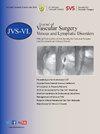Longer term follow-up of a randomized controlled trial on the role of compression after radiofrequency ablation of varicose veins
IF 2.8
2区 医学
Q2 PERIPHERAL VASCULAR DISEASE
Journal of vascular surgery. Venous and lymphatic disorders
Pub Date : 2025-01-01
DOI:10.1016/j.jvsv.2024.101963
引用次数: 0
Abstract
Objective
Several studies have shown that, in the short term, treatment outcomes following endothermal ablation of varicose veins without the prescription of post procedural compression are not inferior to outcomes when compression is routinely prescribed. This follow-up to our randomized controlled trial (RCT) published in 2020 explores whether the non-inferiority persists into the medium to long term.
Methods
All 94 patients from the RCT were recalled at 27 months after their initial radiofrequency ablation (RFA) procedure. The procedural details, randomization, and inclusion and exclusion criteria were described in the original RCT paper. Consent was obtained for further venous duplex ultrasound scan at 27 to 61 months after the initial procedure. The successful target vein closure at this juncture represented our primary outcome. Secondary outcomes include disease severity, measured using the Aberdeen Varicose Vein Severity Score (AVSS) and the Revised Venous Clinical Severity Score (RVCSS), post-procedural pain measured using Likert scale, and number of days taken for patients to return to work or normal activities.
Results
Thirty-one of 48 patients (64.6%) in the compression group and 29 of 46 patients (63%) in the no-compression group were evaluated. The mean duration of follow-up was 43 and 42 months in the compression and no-compression group, respectively. The target vein occlusion rate evaluated at this longer-term follow up were 80.7% and 79.3% in the compression and no-compression groups, respectively. There was no significant difference between the two groups (P = .37). Secondary outcomes of quality of life and disease severity measured using AVSS and RVCSS showed no significant difference between the two groups (post-procedural AVSS mean score 5.2 in the compression group vs 8.3 in the no-compression group [95% confidence interval (CI), −7.3 to 1.1; P = .14]; post-procedural RVCSS mean score 1.5 in the compression group vs 1.8 in the no-compression group [95% CI, −1.1 to 0.7; P = .59]). Patient satisfaction was similar in both groups (mean score 6.4 in the compression group vs 5.9 in the no-compression group [95% CI, −0.22 to 1.17; P = .18]), and the number of days taken for patients to return to work were also comparable (mean of 11.9 days in the compression group vs 12.6 days in the no-compression group [95% CI, −7.7 to 6.2; P = .83]).
Conclusions
This study provided some evidence to support no additional benefit of compression use after RFA at a longer term follow-up of 3 years. However, larger, suitably powered studies would be beneficial to confirm this.
静脉曲张射频消融术后加压作用随机对照试验的长期随访。
导言:多项研究表明,在短期内,静脉曲张内热消融术后不进行术后压迫的治疗效果并不比常规压迫的效果差。本研究是对 2020 年发表的随机对照试验(RCT)的后续研究,旨在探讨这种不劣势是否会持续到中长期:方法:在首次射频消融(RFA)术后27个月,对RCT试验中的所有94名患者进行回访。手术细节、随机化、纳入和排除标准在原始 RCT 论文中均有描述。在首次手术后的 27 至 61 个月,患者同意接受进一步的静脉 Duplex 超声波扫描。在这一时刻成功关闭靶静脉代表了我们的主要结果。次要结果包括使用阿伯丁静脉曲张严重程度评分(AVSS)和修订静脉临床严重程度评分(RVCSS)测量的疾病严重程度、使用李克特量表测量的术后疼痛以及患者恢复工作或正常活动所需的天数:对加压组 48 名患者中的 31 名(64.6%)和无加压组 46 名患者中的 29 名(63%)进行了评估。加压组和无加压组的平均随访时间分别为 43 个月和 42 个月。在长期随访中评估的靶静脉闭塞率,加压组和不加压组分别为 80.7% 和 79.3%。两组之间无明显差异(P = 0.37)。使用 AVSS 和 RVCSS 测量的生活质量和疾病严重程度的次要结果显示,两组之间无显著差异(压迫组术后 AVSS 平均得分为 5.2,无压迫组为 8.3,[95% CI -7.3 至 1.1,p = .14];压迫组术后 RVCSS 平均得分为 1.5,无压迫组为 1.8,[95% CI -1.1 至 0.7,p = .59])。两组患者的满意度相似(加压组平均得分为6.4分,无加压组为5.9分,[95% CI -0.22至1.17,p = .18]),患者重返工作岗位的天数也相当(加压组平均为11.9天,无加压组为12.6天,[95% CI -7.7至6.2,p = .83]):这项研究提供了一些证据,证明在较长期的三年随访中,RFA 后使用加压疗法不会带来额外的益处。然而,更大规模的、有适当动力的研究将有助于证实这一点。
本文章由计算机程序翻译,如有差异,请以英文原文为准。
求助全文
约1分钟内获得全文
求助全文
来源期刊

Journal of vascular surgery. Venous and lymphatic disorders
SURGERYPERIPHERAL VASCULAR DISEASE&n-PERIPHERAL VASCULAR DISEASE
CiteScore
6.30
自引率
18.80%
发文量
328
审稿时长
71 days
期刊介绍:
Journal of Vascular Surgery: Venous and Lymphatic Disorders is one of a series of specialist journals launched by the Journal of Vascular Surgery. It aims to be the premier international Journal of medical, endovascular and surgical management of venous and lymphatic disorders. It publishes high quality clinical, research, case reports, techniques, and practice manuscripts related to all aspects of venous and lymphatic disorders, including malformations and wound care, with an emphasis on the practicing clinician. The journal seeks to provide novel and timely information to vascular surgeons, interventionalists, phlebologists, wound care specialists, and allied health professionals who treat patients presenting with vascular and lymphatic disorders. As the official publication of The Society for Vascular Surgery and the American Venous Forum, the Journal will publish, after peer review, selected papers presented at the annual meeting of these organizations and affiliated vascular societies, as well as original articles from members and non-members.
 求助内容:
求助内容: 应助结果提醒方式:
应助结果提醒方式:


